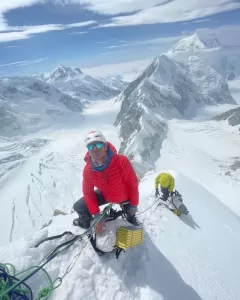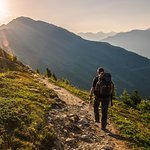Strategies & Style
The Cassin Ridge is a huge undertaking for any climber, and there are several ways in which we might attempt the route, depending to some extent on conditions, but also on the strength of the climbing team. A common manner to attempt the route is to acclimatize on the West Buttress, before attempting the climb in alpine style. The following itinerary reflects this strategy. As with any itinerary for climbing a big, cold mountain, the following is merely a rough outline of what might happen on any given day, and is subject to change for any number of reasons.
DAY 1: MEET IN ANCHORAGE. Our Team Meetings are generally scheduled at 10 a.m. for an expedition orientation and equipment check. This is a very important meeting, which all climbers must attend. Be sure to arrive in Anchorage early enough to make the meeting; which may require arriving a day early. Our trip fee includes two nights accommodation at the Millennium Alaska Hotel, which is conveniently located and offers free airport transfers.
DAY 2: TRAVEL TO TALKEETNA AND FLY TO THE GLACIER. We provide transportation to Talkeetna for all of our Denali climbers, using our own vans and trailers so we are not tied to a third party’s schedule. The drive takes a bit more than two hours, and we’ll stop for coffee and snacks along the way. Once in Talkeetna, we’ll need to unload, organize, and weigh all of our equipment and supplies in preparation for our flight to the glacier. We will also finish the registration process with the National Park Service (NPS) and attend a pre-climb orientation provided by one of the NPS climbing rangers. After finalizing all the NPS admin steps, we’ll fly to the glacier, weather permitting. Once on the Southeast Fork of the Kahiltna Glacier, we’ll be busy establishing our camp for the night.
DAY 3: SINGLE CARRY TO 7,800′ CAMP. Departing Base Camp, we’ll drop down the infamous Heartbreak Hill and onto the broad Kahiltna Glacier. Our goal will be to move camp to about 7,800′, near the junction with the NE Fork of the Kahiltna Glacier. This is a moderately tough day of about 9 miles round trip, and is a good shakeout for the upcoming days. Depending on the team and weather we may or may not carry loads and return to Base Camp. Throughout the expedition we’ll typically follow the “climb high, sleep low” technique for better acclimatization; however, the altitude difference between Base Camp and 7,800 Camp is minimal enough to permit us to generally “single carry” this stretch. On the late May and June expeditions, we may be doing our climbing early in the morning to avoid the excessive heat and soft snow conditions on the Lower Glacier.
DAY 4: SINGLE CARRY TO 9,700′. We’ll head out of 7,800 Camp and carry loads up the 1,800′ Ski Hill. Several options exist for camp sites between 9,000′ and 11,000′, depending upon weather, snow conditions and team strength. This is a moderately difficult carry of 3-4.5 miles, with 2,000′ to 3,000′ of elevation gain.
DAY 5: MOVE TO 11,200 CAMP. Our third camp is often in the 11,200′ basin at the base of Motorcycle Hill. This is an incredibly beautiful camp that basks in alpenglow when the sun travels around the north side of the mountain.
DAY 6: REST/ACCLIMATIZATION DAY. We just moved rather quickly from sea level to 11,200′, so it’s often prudent to slow things down a bit and allow our bodies to acclimate a bit before pushing up to the big camp at 14,200′.
DAY 7: HAUL LOADS AROUND WINDY CORNER (13,300′). Steep snow climbing up the 1,000′ high Motorcycle Hill rewards you with spectacular views. The total distance for the day is about 4 miles round trip with a little more than 2,000′ of elevation gain. Fun climbing with crampons and an ice axe gets you around Windy Corner, where the upper mountain comes into view—have your camera ready!
DAY 8: MOVE CAMP TO 14,200′. This is usually a long, hard day. Our next camp is generally located at the well-equipped 14,200 Camp in the expansive Genet Basin. Loads are getting lighter and the air is getting thinner. Hopefully everyone will have enough energy left to help get camp set up as we need to fortify this camp due to the possibility of fairly severe weather.
DAY 9: ACCLIMATIZATION DAY. This is an important day that helps provide the foundation of acclimatization that we’ll need for climbing higher on Denali. We’ll review a variety of climbing techniques during the day and might have a chance to walk over to a dramatically scenic spot known as “The Edge of the World.”
DAY 10: CLIMB HIGHER TO FURTHER DEVELOP ACCLIMATIZATION. We have options as to whether we climb up the West Buttress route and out the ridge that leads to the 17,200 Camp, or we can climb up to the high camps on the West Rib. Either will serve us well.
DAY 11: DESCEND TO OUR 7,800 CAMP. We’ll drop back down to the site of our cache at 7,800′ in preparation for pushing up the NE Fork of the Kahiltna towards our route.
DAY 12-13: MOVE UP THE NE FORK TO THE BASE OF THE ROUTE. As with much of this expedition, we have options as to how we move up the NE Fork of the Kahiltna and where we camp. Team strength and conditions will dictate our strategy.
DAY 14-20: CLIMBING THE CASSIN! Weather, team strength, conditions, and health will all direct our team decision-making for where we camp, and how we move up the route. It could easily take a week to climb up the route and descend back to our cache at 14,200′.
DAY 21-26(+): CONTINGENCY/DESCENT DAYS. Weather will probably slow us down at some point, and it will take a day to reach the airstrip from our cache at 14,200′. As we book these trips on a private, custom basis, your schedule will dictate how many days we have to devote to contingency days. There comes a point of diminishing returns, whereby, if you bring too many extra days of food, the weight will slow you down so much that you’ll need to use them. We’ll discuss this at length with any prospective climber.









